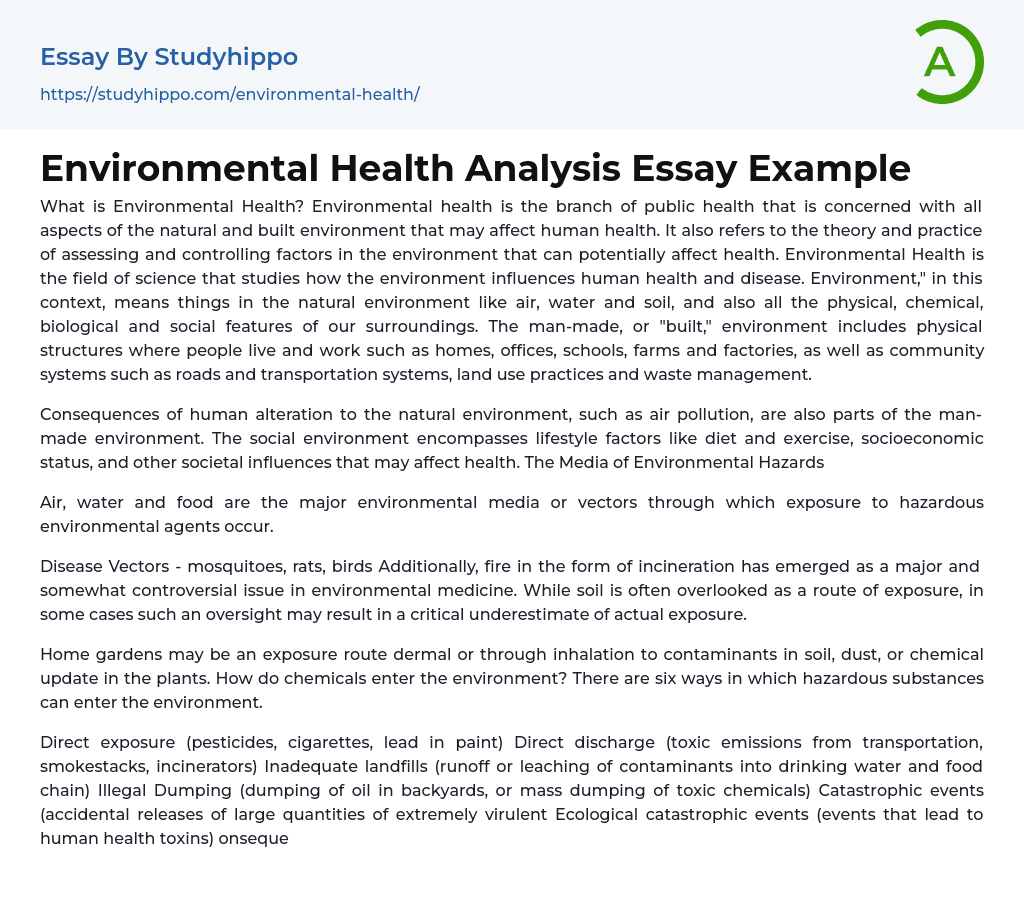Environmental Health is the study of how the environment affects human health and disease, which is a part of public health. It looks at both natural and man-made environments, assessing and controlling factors that can affect our health. The term "environment" includes things like air, water, soil, as well as physical, chemical, biological, and social aspects of our surroundings. The "built" environment refers to buildings where people live and work (such as homes, offices, schools), as well as community systems like roads, transportation systems, land use practices, and waste management.
The man-made environment includes consequences of human alteration to the natural environment, such as air pollution. The social environment encompasses factors like diet, exercise, socioeconomic status, and societal influences that may affect health. The Media of Environmental Hazards.
Air, water, and food serve as the primary channels for exposure to hazard
...ous environmental agents.
Disease vectors, such as mosquitoes, rats, and birds, are a concern in environmental medicine. The incineration of waste is also a significant issue, albeit controversial. Additionally, soil exposure should not be ignored as it can lead to underestimated exposure in certain cases.
Chemicals can potentially enter the environment through home gardens, posing a risk through dermal exposure or inhalation. Contaminants in soil, dust, or chemical updates in plants are six pathways through which hazardous substances can contaminate the environment.
The text highlights a range of environmental hazards and their significance in different environments. These hazards include exposure to pesticides, cigarettes, and lead in paint. It also addresses the direct release of toxic emissions from transportation, smokestacks, and incinerators. The lack of sufficient landfills contributes to the contamination of drinking water and
the food chain through runoff or leaching of pollutants. Improper disposal of oil or mass dumping of toxic chemicals is classified as illegal dumping. Additionally, there are potential threats posed by catastrophic events such as accidental releases of large amounts of highly virulent toxins and ecological disasters like volcanoes, floods, famine, and hurricanes that can have adverse effects on human health.
Moreover, the text mentions various types of chemical agents (such as pesticides), volatile organic compounds (VOCs), polychlorinated biphenyls (PCBs), physical agents (including ionizing and non-ionizing radiation, vibration, temperature), and biological agents encompassing infectious diseases, allergic disorders as well as noise pollution that can harm the environment.
When evaluating the relationship between humans and dangerous exposures, there are four crucial factors to consider: route (inhalation, ingestion, and dermal), magnitude (concentration or dose), duration (minutes, hours, days, or lifetime), and frequency (daily, weekly, monthly, or seasonally). Risk assessments should include all environmental media as potential exposure routes. Humans can come into contact with environmental toxins through contaminated food, water, and air. Hazardous pollutants can also enter the human body through the skin or a combination of these routes. It is rare for humans to encounter a single pollutant solely through one route.
Understanding the concept of "dose" in environmental medicine relies on the relationship between magnitude, duration, and frequency. The amount of toxicant absorbed and the time factors determine the dose. Biological responses can occur even at low concentrations of a toxicant. In fact, a small concentration of an extremely toxic substance can still have a significant clinical effect.
To accurately assess human exposure to a specific hazardous pollutant in the environment, direct measurement of exposure is
crucial. There are three methods to achieve this measurement:
- Use of micro-environmental samplers
- Use of personal monitors
- Use of biologic measurements in human tissue
- Animal Welfare essays
- Zoo essays
- Plastic essays
- Waste Management essays
- Climate Change essays
- Global Warming essays
- Conservation essays
- Recycling essays
- Anatomy and Physiology essays
- Addiction essays
- Biodegradation essays
- Dental Care essays
- Disease essays
- Disorders essays
- Health Care essays
- Intelligence Quotient essays
- Nutrition essays
- Olfaction essays
- Public Health essays
- Women's Health essays
- World health organization essays
- Cancer essays
- Infectious Disease essays
- Lung Cancer essays
- Neurology essays
- Physical Exercise essays
- Medicine essays
- Sex essays
- Inquiry essays
- Disability essays
- Poison essays
- Action Potential essays
- Nervous System essays
- Childbirth essays
- Puberty essays
- Blood essays
- Kidney essays
- Neuron essays
- Body essays
- Glucose essays
- Sense essays
- Heart essays
- Skeleton essays
- Human Physiology essays
- Eye essays
- Immune System essays
- Muscle essays
- Skin essays
- Brain essays
- Central Nervous System essays




